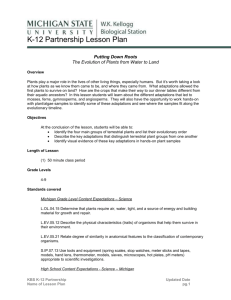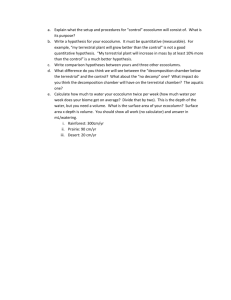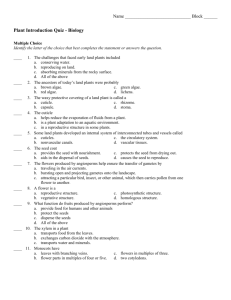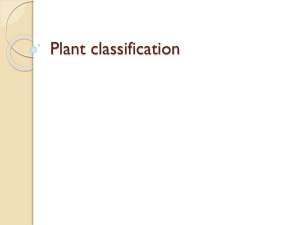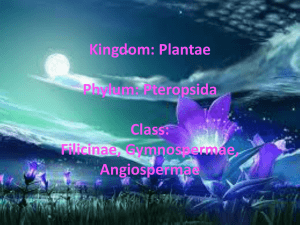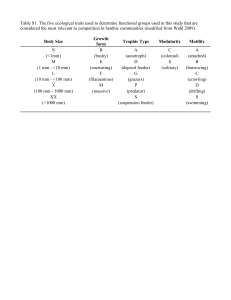Lesson Plan - KBS GK12 Project
advertisement
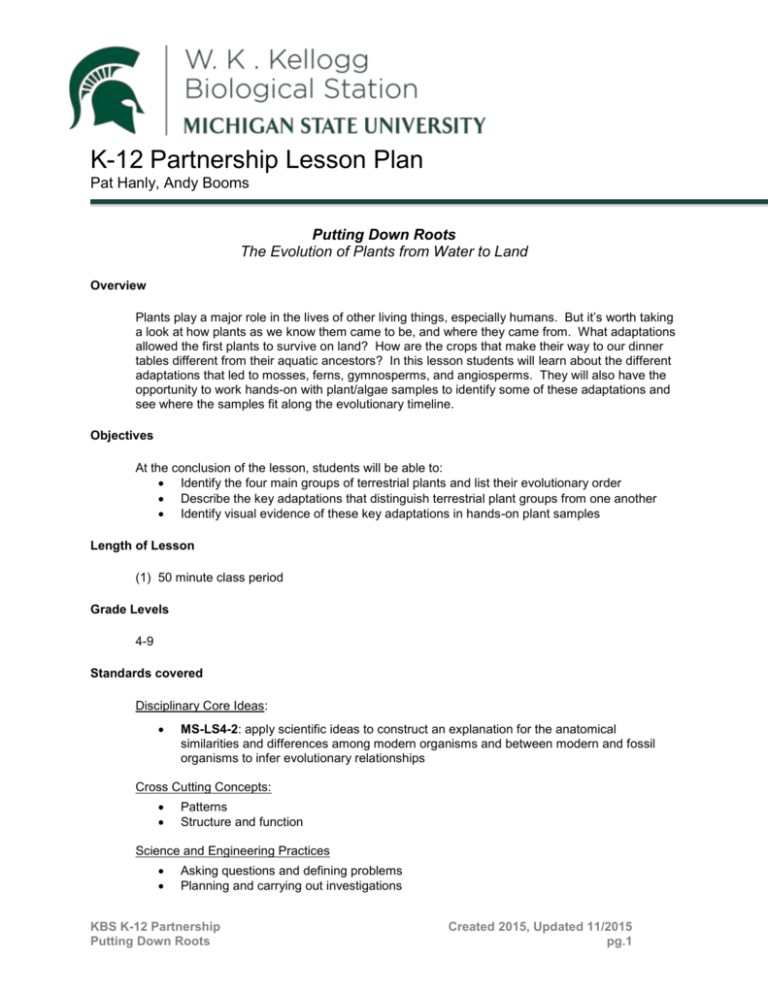
K-12 Partnership Lesson Plan Pat Hanly, Andy Booms Putting Down Roots The Evolution of Plants from Water to Land Overview Plants play a major role in the lives of other living things, especially humans. But it’s worth taking a look at how plants as we know them came to be, and where they came from. What adaptations allowed the first plants to survive on land? How are the crops that make their way to our dinner tables different from their aquatic ancestors? In this lesson students will learn about the different adaptations that led to mosses, ferns, gymnosperms, and angiosperms. They will also have the opportunity to work hands-on with plant/algae samples to identify some of these adaptations and see where the samples fit along the evolutionary timeline. Objectives At the conclusion of the lesson, students will be able to: Identify the four main groups of terrestrial plants and list their evolutionary order Describe the key adaptations that distinguish terrestrial plant groups from one another Identify visual evidence of these key adaptations in hands-on plant samples Length of Lesson (1) 50 minute class period Grade Levels 4-9 Standards covered Disciplinary Core Ideas: MS-LS4-2: apply scientific ideas to construct an explanation for the anatomical similarities and differences among modern organisms and between modern and fossil organisms to infer evolutionary relationships Cross Cutting Concepts: Patterns Structure and function Science and Engineering Practices Asking questions and defining problems Planning and carrying out investigations KBS K-12 Partnership Putting Down Roots Created 2015, Updated 11/2015 pg.1 Engaging in argument from evidence Previous Michigan Standards Met: L.OL.04.15: determine that plants require air, water, light, and a source of energy and building material for growth and repair. L.EV.05.12: describe the physical characteristics (traits) of organisms that help them survive in their environment. L.EV.05.21: relate degree of similarity in anatomical features to the classification of contemporary organisms. S.IP.07.13: use tools and equipment (spring scales, stop watches, meter sticks and tapes, models, hand lens, thermometer, models, sieves, microscopes, hot plates, pH meters) appropriate to scientific investigations. B4.3C: Give examples of ways in which genetic variation and environmental factors are causes of evolution and the diversity of organisms. Materials Elementary o Introductory Powerpoint – Elementary (see attached) o Blank paper - for drawing first land plant o Plant samples for hands-on examination (see end of intro powerpoint for ideas) Middle School o Introductory Powerpoint – Middle (see attached) o Worksheet (see attached) o Microscopes – compound and/or dissecting o Slides and slide covers o Razor blades, scissors, or scalpels for preparing samples for slides o Aquatic angiosperm (1 species) o Algae (1 species) o Terrestrial angiosperm (1 species) Background Despite the ubiquity of plants in everyday surroundings, many students don’t realize that most of the plant species they see, and eat, on a regular basis belong to just one group of terrestrial plants – angiosperms. Angiosperms are also the most recently evolved of the four groups of terrestrial plants. The evolutionary path to these common plants began around 450 million years ago when plants first left aquatic environments and began colonizing land. The earliest group of terrestrial plants – the mosses – were able to survive on dry land because of a new adaptation called a cuticle, which is a waxy layer that protects the outer surface of the plant and prevents it from drying out. However, mosses still require moist environments because they rely on water to facilitate reproduction. The next group of plants to evolve – the ferns – are distinguished from mosses by the presence of a vascular system (xylem/phloem) that allows the plant to transport water and nutrients throughout its body. This adaptation allows ferns to grow taller and still distribute vital materials from top to bottom (and vice versa). Like mosses, ferns must live in moist areas because of the reliance on water to facilitate reproduction. Gymnosperms were the next group of terrestrial plants to appear, and are distinguished by the presence of seeds. Seeds allow future plant generations to survive periods of harsh conditions (like droughts) that kill the parent plants. Having seeds allows gymnosperms to survive and thrive in dryer areas that mosses and ferns can’t tolerate. The most recently evolved group of land plants – the angiosperms – have flowers and fruits, adaptations not seen in gymnosperms or earlier groups. Flowers and fruits allow angiosperms to attract pollinators that facilitate the spread of pollen and seeds over far greater distances than can KBS K-12 Partnership Putting Down Roots Created 2015, Updated 11/2015 pg.2 be achieved by the offspring of earlier plant groups. It is also this set of features that has brought angiosperms into such close relationships with humans - fields full of crops and vases, planters, or gardens full of ornamental flowers are everyday sights for many students. Activities of the session Elementary 1. Provide students with a variety of plant samples from across the four groups of terrestrial plants (mosses, ferns, gymnosperms, angiosperms) and tell them that the samples can all be separated into 4 distinct groups. Without telling the students which group each plant belongs to, ask them to identify (in pairs, groups, or as a class) similarities and differences between samples or any characteristics that allow them to group samples together. Have students record key features of each of their four groups and which plant samples they placed in each. Some easy/challenging sample suggestions are listed in the final slides of the introductory powerpoint. 2. Describe the evolutionary history of terrestrial plants using the introductory powerpoint (elementary version). 3. Ask students to repeat Step #1 now that they know the characteristics that make each of the four plant groups unique. Middle 1. Provide students with Putting Down Roots worksheet 2. Describe the evolutionary history of terrestrial plants using the introductory powerpoint (middle school version). Students should follow along on worksheet and record information as necessary to complete Page 1. 3. Provide students with samples of three species: one terrestrial plant (angiosperm), one aquatic plant (angiosperm), and one algae. Following the directions of Page 2 of the worksheet (and using the information on Page 1 to help), students will examine each specimen and look for the presence of each of the key evolutionary traits of terrestrial plants. Students may use the naked eye, dissecting microscopes to more closely observe the specimens, and/or prepare cross-sections on slides for compound microscopes as necessary to identify key features. For an added challenge: Use Coontail (Ceratophyllum demersum), an aquatic angiosperm that has lost its cuticle and roots. You may also want to use an algae species that has many similarities to land plants such as Chara. Both of these organisms are common and easy to find in temperate shallow ponds and lakes. 4. Based on their examination in Step #3, students should reach conclusions on: 1) which plant group Specimen A belongs to, and 2) which specimen (B or C) is an aquatic plant of the same group as Specimen A and which (B or C) is actually a species of algae (not a plant at all). KBS K-12 Partnership Putting Down Roots Created 2015, Updated 11/2015 pg.3 Resources Background on evolution of terrestrial plants o http://www.gwu.edu/~darwin/BiSc151/Plants1/plant1.html Important global crops o http://www.businessinsider.com/10-crops-that-feed-the-world-2011-9# Extensions and Modifications Students can collect their own plants and algae prior to this activity during an additional class period or for homework. They can then have the added opportunity to classify their own plant within this lesson’s framework. For added depth, students could make observations about the habitats where they found their specimens and come up with scenarios for when that plant may need each of the traits they learn about. After learning about the evolution of traits across the biggest groupings of plants, students could each be given an individual plant family and investigate what traits define that plant family and its constituent species. They can present their findings orally to the class or as an illustrated report. Assessment Students can be asked to illustrate a timeline of plant evolution, including dates of each evolutionary step and drawings of what a plant community might look like over time. Students can be given different environments where they must “design” a plant to survive those conditions using the traits they have learned about. They can be encouraged to add in other traits they can come up with and see if actual plants have evolved similar traits in those environments. KBS K-12 Partnership Putting Down Roots Created 2015, Updated 11/2015 pg.4
